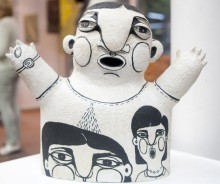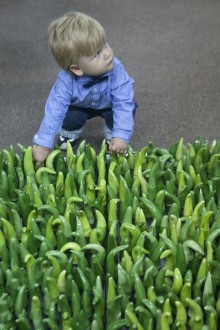“A house is cold without ceramics,” says Hanna Drul, artist from Lviv, a participant of TseHlyna-2016 festival. On display are Hanna’s “Landscape” and “Meteorites,” works alluding to something cosmic, extraterrestrial. Overall, this year’s TseHlyna has a lot of unusual. For example, Ivan Fizer’s strange creations: “Bizarre,” “Alien,” and “Sandy.” Different “Heads” by Oleksandr Miroshnychenko break down into several fragments and on each emerges an outline of a face.
In total, the festival has presented over 70 works by 33 authors from Ukraine, Poland, Lithuania, and Japan – it is the first time it has acquired international status. The event is hosted by a new location – the ceramic art space TseHlynaArt, which was opened just before the festival. The project idea was created by a ceramist Olesia Dvorak-Halik. She and Yulia Ostrovska went on to become curators of TseHlyna-2016. The project is endorsed by a charitable organization Sky Art Foundation.
The organizers want to introduce as many people as possible to the art of ceramics. Thus, four works presented at TseHlyna are tactile – people with visual impairments can feel them on touch. One of these is “Corpuscle” By Giya Miminoshvili from Kyiv. The work consists of two merging spheres. Or, equally, they might as well be un-merging – it depends on how you interpret it. The spheres are hollow, with conical objects hiding inside – moving them would make different sounds, as these objects are made of different materials. The work is left unpainted deliberately – the artist wanted blind people to feel the fire sand, of which it is made of. “I combine dynamics, rhythm, sound. The work should be some kind of a labyrinth,” says Miminoshvili. The artist believes that people with visual impairments will understand his sculpture better than keen-sighted, because they have a better sense of shape.
Festival participants are encouraged to experiment, but the basic components of ceramic work have not changed for centuries. “Clay, burning, watering and the artist’s idea are the main things,” lists Dvorak-Halik. And Drul admits: “Ceramists are terrible workaholics! They are very attached to the furnace and very rarely attend social gatherings. The workshop and the furnace come above all; pottery is a time-consuming hard work.” Iryna Marko, another ceramist from Lviv, adds that an artwork can sometimes be repainted up to five times – as the artist wants to improve it.
“Ceramists are artists who work with volume. And we are fighting for the high art status of pottery,” continues Dvorak-Halik. Now this form of art can be discovered through the entire year: she promises that TseHlynaArt will regularly host events related to ceramics.
This year’s TseHlyna festival will continue through August 24. The organizers have prepared an extensive program of discussions, workshops, presentations of personal projects, lectures and more. The event, which takes place on Podil, in TseHlynaArt space, is worth visiting.








